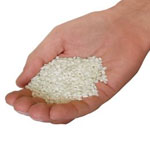In 2006, the technology faculty of the University of Santiago in Chile (USACH) created an innovative rice product made from waste material left over from the traditional process of cutting rice. This new rice is very similar to traditional rice in flavor and aroma but its production costs are 40% lower. The new product is appealing to consumers, according to surveys made by the USACH, which is negotiating with food companies to commercialize it. What impact will this product have on the Chilean and regional economy? What are the chief obstacles standing in its way?

Sign up to stay informed about our latest article releases.